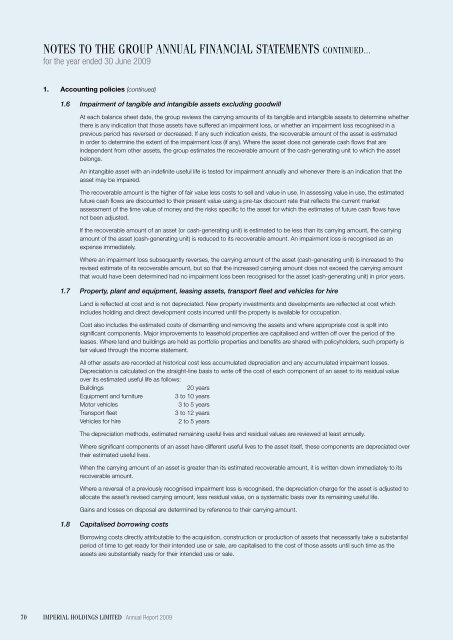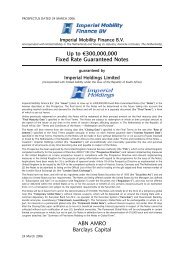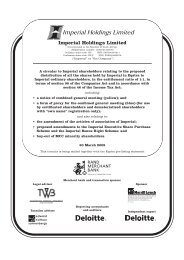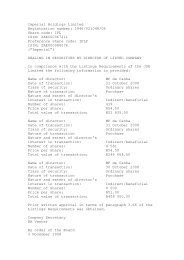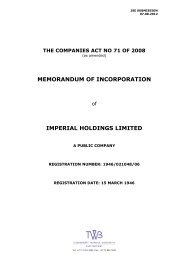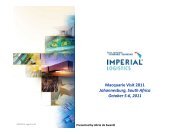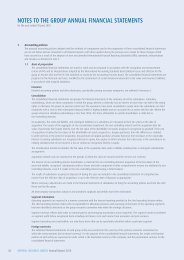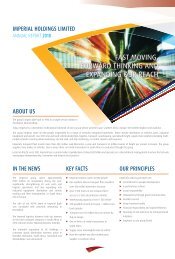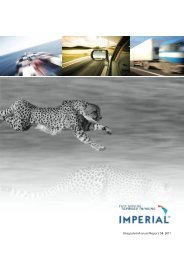4.0 - Imperial
4.0 - Imperial
4.0 - Imperial
You also want an ePaper? Increase the reach of your titles
YUMPU automatically turns print PDFs into web optimized ePapers that Google loves.
Notes to the group annual financial statements continued...<br />
for the year ended 30 June 2009<br />
1. Accounting policies (continued)<br />
1.6 Impairment of tangible and intangible assets excluding goodwill<br />
At each balance sheet date, the group reviews the carrying amounts of its tangible and intangible assets to determine whether<br />
there is any indication that those assets have suffered an impairment loss, or whether an impairment loss recognised in a<br />
previous period has reversed or decreased. If any such indication exists, the recoverable amount of the asset is estimated<br />
in order to determine the extent of the impairment loss (if any). Where the asset does not generate cash flows that are<br />
independent from other assets, the group estimates the recoverable amount of the cash-generating unit to which the asset<br />
belongs.<br />
An intangible asset with an indefinite useful life is tested for impairment annually and whenever there is an indication that the<br />
asset may be impaired.<br />
The recoverable amount is the higher of fair value less costs to sell and value in use. In assessing value in use, the estimated<br />
future cash flows are discounted to their present value using a pre-tax discount rate that reflects the current market<br />
assessment of the time value of money and the risks specific to the asset for which the estimates of future cash flows have<br />
not been adjusted.<br />
If the recoverable amount of an asset (or cash-generating unit) is estimated to be less than its carrying amount, the carrying<br />
amount of the asset (cash-generating unit) is reduced to its recoverable amount. An impairment loss is recognised as an<br />
expense immediately.<br />
Where an impairment loss subsequently reverses, the carrying amount of the asset (cash-generating unit) is increased to the<br />
revised estimate of its recoverable amount, but so that the increased carrying amount does not exceed the carrying amount<br />
that would have been determined had no impairment loss been recognised for the asset (cash-generating unit) in prior years.<br />
1.7 Property, plant and equipment, leasing assets, transport fleet and vehicles for hire<br />
Land is reflected at cost and is not depreciated. New property investments and developments are reflected at cost which<br />
includes holding and direct development costs incurred until the property is available for occupation.<br />
Cost also includes the estimated costs of dismantling and removing the assets and where appropriate cost is split into<br />
significant components. Major improvements to leasehold properties are capitalised and written off over the period of the<br />
leases. Where land and buildings are held as portfolio properties and benefits are shared with policyholders, such property is<br />
fair valued through the income statement.<br />
All other assets are recorded at historical cost less accumulated depreciation and any accumulated impairment losses.<br />
Depreciation is calculated on the straight-line basis to write off the cost of each component of an asset to its residual value<br />
over its estimated useful life as follows:<br />
Buildings<br />
20 years<br />
Equipment and furniture<br />
3 to 10 years<br />
Motor vehicles<br />
3 to 5 years<br />
Transport fleet<br />
3 to 12 years<br />
Vehicles for hire<br />
2 to 5 years<br />
The depreciation methods, estimated remaining useful lives and residual values are reviewed at least annually.<br />
Where significant components of an asset have different useful lives to the asset itself, these components are depreciated over<br />
their estimated useful lives.<br />
When the carrying amount of an asset is greater than its estimated recoverable amount, it is written down immediately to its<br />
recoverable amount.<br />
Where a reversal of a previously recognised impairment loss is recognised, the depreciation charge for the asset is adjusted to<br />
allocate the asset’s revised carrying amount, less residual value, on a systematic basis over its remaining useful life.<br />
Gains and losses on disposal are determined by reference to their carrying amount.<br />
1.8 Capitalised borrowing costs<br />
Borrowing costs directly attributable to the acquisition, construction or production of assets that necessarily take a substantial<br />
period of time to get ready for their intended use or sale, are capitalised to the cost of those assets until such time as the<br />
assets are substantially ready for their intended use or sale.<br />
70<br />
<strong>Imperial</strong> holdings limited Annual Report 2009


